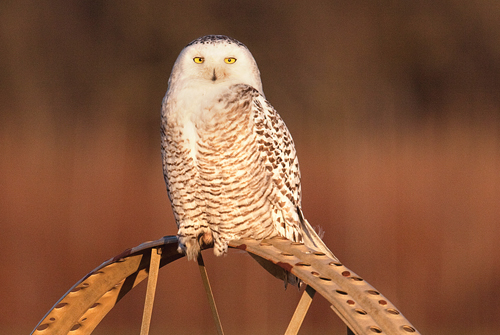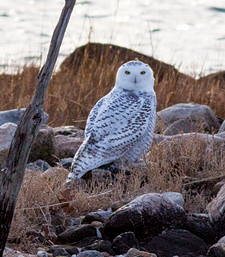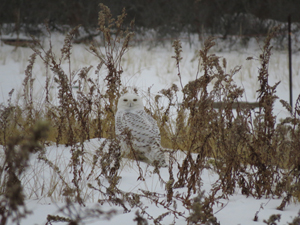Snowy owls spotted across the North Fork

Avid bird lovers and nature buffs alike have been looking to the skies more frequently in recent weeks, trying to spot the long-admired snowy owl — whose population is “irrupting” this season, experts say.
An irruption is a spectacular, unscheduled migration of large numbers of birds to areas they usually bypass, said Don Bindler, an avid East End birder. While it’s not uncommon for snowy owls to migrate to the North Fork, this season’s irruption has been one of the largest on record, with as many as several hundred birds migrating from their breeding grounds in northern Canada’s tundra to the northern coastlines of the United States, Mr. Bindler said.

Locally, the birds have been spotted as far west as the former Grumman property in Calverton to as far east as Orient State Park and Plum Island, according to a joint website of the Cornell Lab of Ornithology and the National Audubon Society, www.ebird.org, which maps bird sightings. According to the map, snowy owls have also been spotted as far south as Bermuda and Florida — far beyond where they are normally spotted in the states.
The magnificent birds spend their summers north of the Arctic Circle hunting lemmings, ptarmigan and other prey in the 24-hour daylight, according to Cornell.
Unlike most owls, which are nocturnal, the snow white bird is active during all hours — making them easier to spot.
In years with overly abundant prey, the birds can raise double or triple the usual number of young, said Dr. Kevin McGowan of Cornell.
He said that while experts don’t know for sure why the birds are migrating south in such high numbers, a population boom could explain it.
“One reason may be that it is a real big production year,” possibly combined with conditions that aren’t “so good up north and they are having a hard time finding food — or it could be both,” he said.
A single bird may eat more than 1,600 lemmings in one year, Cornell researchers said.
The owls hunt seagulls, ducks, and other small animals on the East End, swooping down to pick up prey with their large, black talons, said Michael Lotito, a nature photographer who regularly contributes his work to the North Fork Audubon Society. So far this season, Mr. Lotito said he has photographed 14 different snowy owls throughout the East End.
“They travel well over 1,000 miles to get here, and because of the distance they generally come down here weak and starving, Mr. Lotito said. “For that reason it’s important that people do not chase them but choose to simply observe them.”
He said that, if approached too closely, the birds lengthen their necks, their first warning sign that they feel danger. They may also simply take flight, fleeing to a safer area.
The birds have been known to stay in one area anywhere from six to 12 hours, and if left undisturbed they can stay in a one-mile radius for the entire winter — provided there is enough food, he said.
Generally, the youngest birds, about a year old, will migrate from the arctic first, pushed out by their elders when fighting over territory, the Cornell researchers said.
The snowy owl is the continent’s heaviest owl, weighing between three and six pounds, depending on what they have had to eat at a certain time, and adults have a wingspan between four and five feet. Males are typically smaller than females.
“They are very quiet and calculating,” Mr. Lotito said, adding that, like all owls, they are silent in flight because of the configuration of their wing feathers, allowing them to surprise and pounce on their prey.
They can down a rodent headfirst in a single gulp, according to Cornell.
Aside from their snow-white feathers, the birds are best known for their cat-like yellow eyes.

Male owls are white with dark brown spots when they’re young, which disappear as they age. Females keep some dark markings throughout their lives.
For those hoping to catch a glimpse of the coastal birds, Mr. Lotito recommends going to Orient State Park, along the shoreline. Snowy owls like open dune areas and open fields, he said.
This Saturday, the Group for the East End will be holding an informational event about owls common to the North Fork, giving participants the chance to dissect owl pellets at Down Farm Preserve on Main Road in Cutchogue and learn about their diets.
The event, geared toward families, will also provide information on the snowy owl and its abundance this season. A $5 donation per family is suggested. For event times and more information contact Christine Tylee at (631) 765-6450 ext. 208.







